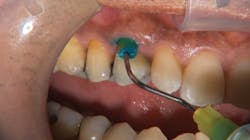Rapid Anesthesia Technique now predictably successful
by Michael DiTolla, DDS, FAGD
For more on this topic, go to www.dentaleconomics.com and search using the following key words: Rapid Anesthesia Technique, lower blocks, PDL injection, Dr. Michael DiTolla.I have mentioned in previous DE columns that I have pretty much stopped giving lower blocks since I learned the components of the Rapid Anesthesia Technique.This technique was born of my frustration of missing lower blocks on the first attempt, and at other times, having patients who said they weren't numb. But every time the bur hit the distobuccal line angle, for example, the patients jumped. In addition to the IA block being missed as much as 20% of the time, according to experts, it often left patients sore since the needle had to go through two pterygoid muscles to get to its target.
Once I discovered PFG Lite gel from Steven's Pharmacy (stevensrx.com, 800-352-DRUG), I realized I could get needle penetration anywhere without pain for the patient. This includes a PDL injection such as the Rapid Anesthesia Technique. The gel contains lidocaine, prilocaine, and tetracaine, so I am not surprised that it works much better than conventional topicals. The gel is left at the injection site for 30 to 45 seconds and then rinsed off.
For the PDL injection, a few drops of Septocaine are expressed into the sulcus for five to eight seconds and then the needle is advanced through the attachment. For a standard infiltration, the tissue is pulled taut, and the needle is slightly rotated since it punctures the mucosa.
The Rapid Anesthesia Technique did not become predictably successful until I found the STA device from Milestone Scientific (www.stais4u.com). Specifically designed for single-tooth anesthesia (but fantastic for all injections), it has a small computer inside the unit that gives you audio and visual feedback as you inject into the PDL space.
About six months ago, a female patient complained that she looked like she had suffered a stroke after a standard infiltration for a crown on a bicuspid. That was the day I wondered why I had not used the STA on her for a PDL injection with no soft-tissue effects. The next day another patient needed a crown on a bicuspid, and it was so nice to be able to brag about my "stroke-free" technique. For more about the technique, see the photos on the right.
Dr. Michael DiTolla is the Director of Clinical Research and Education at Glidewell Laboratories in Newport Beach, Calif. He lectures nationwide on both restorative and cosmetic dentistry. Dr. DiTolla has several free clinical programs available online or on DVD at www.glidewelldental.com.

